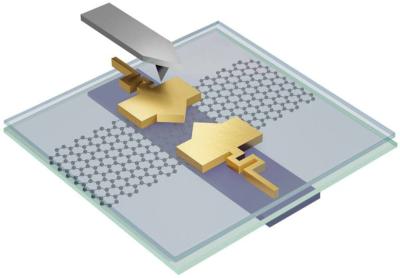Researchers at University of California, Irvine, working with a team from Japan's National Institute for Materials Science, have reported the discovery of nano-scale devices that can transform into many different shapes and sizes even though they exist in solid states. This comes in contrast to conventional nano-scale electronic parts in devices like smartphones, that are solid, static objects that once designed and built cannot transform into anything else. This recent finding could fundamentally change the nature of electronic devices, as well as the way scientists research atomic-scale quantum materials.
Schematic of an hBN-encapsulated graphene device with a local graphite back gate and flexible serpentine leads connected to the movable QPC top gates (metal contacts to the graphene and graphite not shown). Image from Science Advances
“What we discovered is that for a particular set of materials, you can make nano-scale electronic devices that aren’t stuck together,” said Javier Sanchez-Yamagishi, an assistant professor of physics & astronomy whose lab performed the new research. “The parts can move, and so that allows us to modify the size and shape of a device after it’s been made.”
The electronic devices are modifiable – adhered but can be reconfigured into any pattern you like.
The team explained that interfaces of van der Waals (vdW) materials, such as graphite and hexagonal boron nitride (hBN), exhibit low-friction sliding due to their atomically flat surfaces and weak vdW bonding. They demonstrate that microfabricated gold also slides with low friction on hBN. This enabled the arbitrary post-fabrication repositioning of device features both at ambient conditions and in situ to a measurement cryostat.
The scientists demonstrated mechanically reconfigurable vdW devices where device geometry and position are continuously tunable parameters. By fabricating slidable top gates on a graphene-hBN device, they produced a mechanically tunable quantum point contact where electron confinement and edge-state coupling can be continuously modified. Moreover, they combine in situ sliding with simultaneous electronic measurements to create new types of scanning probe experiments, where gate electrodes and even entire vdW heterostructure devices can be spatially scanned by sliding across a target.
“The significance of this research is that it demonstrates a new property that can be utilized in these materials that allows for fundamentally different types of devices architectures to be realized, including mechanically reconfigure parts of a circuit,” said Ian Sequeira, a Ph.D student in Sanchez-Yamagishi’s lab.
The research team was not even looking for what they ultimately discovered. “It was definitely not what we were initially setting out to do,” said Sanchez-Yamagishi. “We expected everything to be static, but what happened was we were in the middle of trying to measure it, and we accidentally bumped into the device, and we saw that it moved.”
What they saw specifically was that tiny nano-scale gold wires could slide with very low friction on top of crystals called “van der Waals materials”. Taking advantage of these slippery interfaces, they made electronic devices made of single-atom thick sheets of graphene attached to gold wires that can be transformed into a variety of different configurations on the fly.
“The initial story is more about the basic science of it, although it is an idea which could one day have an effect on industry,” said Sanchez-Yamagishi. “This germinates the idea of it.”
Meanwhile, the team expects their work could usher in a new era of quantum science research.
“It could fundamentally change how people do research in this field,” Sanchez-Yamagishi said. “Researchers dream of having flexibility and control in their experiments, but there are a lot of restrictions when dealing with nanoscale materials,” he added. “Our results show that what was once thought to be fixed and static can be made flexible and dynamic.”
